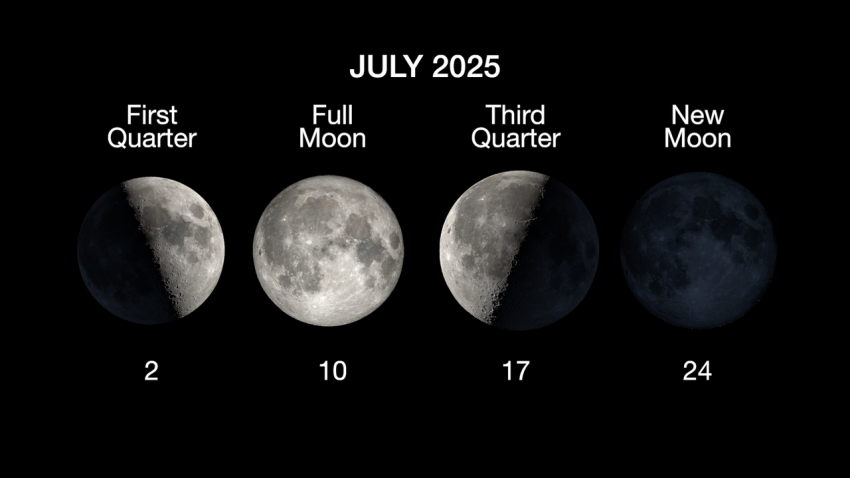Understanding the Moon’s Phases
The moon, Earth’s natural satellite, has fascinated humans for centuries. Its changing appearance in the night sky is a result of its orbit around our planet and the way it reflects sunlight. Today, July 19, 2025, the moon is 24 days old and in the Waning crescent phase, with 31% of its surface illuminated. This phase occurs as the moon moves from the Full Moon toward the New Moon, gradually becoming less visible in the night sky.
Throughout the month of July 2025, the moon will go through several distinct phases. The key dates include:
- First Quarter: July 2
- Full Moon: July 10
- Third/Last Quarter: July 17
- New Moon: July 24
These phases are part of the lunar cycle, which lasts approximately 29.5 days. During this time, the moon transitions through eight main stages: New Moon, Waxing Crescent, First Quarter, Waxing Gibbous, Full Moon, Waning Gibbous, Last Quarter, and Waning Crescent. Each phase represents how much of the moon’s surface is illuminated from Earth’s perspective.
What Causes the Moon to Change Shape?
The moon does not emit its own light; instead, it reflects sunlight. As it orbits Earth, the portion of its surface that is illuminated by the sun changes, creating the illusion of different shapes. For example, during a New Moon, the side facing Earth is completely dark because the moon is positioned between Earth and the sun. Conversely, during a Full Moon, the entire face of the moon is illuminated as it is on the opposite side of Earth from the sun.
The phases are also influenced by the relative positions of the Earth, moon, and sun. When the moon is aligned with the sun, we see a New Moon. When it is directly opposite the sun, we witness a Full Moon. In between, the moon appears as a crescent or gibbous shape depending on how much of its illuminated side is visible.
The Next Major Moon Phase
The next significant milestone in the lunar cycle for July 2025 will be the New Moon, which is scheduled for Thursday, July 24, at 3:11 p.m. ET (1911 GMT). At this point, the moon will be nearly invisible from Earth, as its illuminated side faces away from us. This phase is often considered the start of a new lunar cycle.
During a New Moon, the moon can sometimes align perfectly with the sun, causing a solar eclipse. However, this alignment only happens occasionally due to the moon’s tilted orbit relative to Earth’s orbit around the sun. When a solar eclipse does occur, it can be a rare and spectacular event.
The Impact of Moon Phases on Tides
The moon’s gravitational pull significantly influences Earth’s tides. As the moon orbits Earth, its gravity pulls on the oceans, creating bulges that result in high and low tides. The tides are most extreme when the moon is either a New Moon or a Full Moon, as the gravitational forces of the moon and sun combine. During these times, the tidal range—the difference between high and low tide—is at its maximum. In contrast, when the moon is in the First or Last Quarter phase, the tides are less extreme because the gravitational forces of the sun and moon oppose each other.
Additional Resources for Moon Watching
For those interested in tracking the moon’s phases and related astronomical events, there are several reliable resources available. NASA’s SkyCal Events Calendar provides a detailed overview of lunar and solar eclipses, as well as other celestial phenomena throughout the year. Additionally, there are guides on how to photograph the moon, including tips for capturing its phases and eclipses.
If you’re looking for equipment to observe the moon, there are recommendations for the best telescopes and cameras for astrophotography. These tools can help you explore the moon’s surface and capture stunning images of its changing phases.
Expert Insights on Moon Phases
To gain further insight into the moon’s phases, we spoke with Giuseppe Donatiello, an Italian amateur astronomer, astrophotographer, and author. According to Donatiello, the moon’s phases are a direct result of its motion around Earth in relation to the sun. He explained that the moon does not emit its own light but reflects sunlight, and the amount of illumination we see depends on the angle between the moon, Earth, and sun.
Donatiello also noted that the moon’s rotation is synchronized with its orbit, meaning that the same side always faces Earth. This synchronization, known as tidal locking, is why we never see the far side of the moon from Earth. He added that the moon’s position in the sky changes daily, rising later each day by about 50 minutes, which affects when and where it can be observed.
Conclusion
Understanding the moon’s phases offers a deeper appreciation of the dynamic relationship between Earth and its natural satellite. Whether you’re observing the moon’s gradual transformation from a thin crescent to a full disk, or simply enjoying the beauty of a bright Full Moon, the lunar cycle continues to inspire and captivate. With the right tools and knowledge, anyone can become a skilled observer of the night sky and its ever-changing celestial dance.
